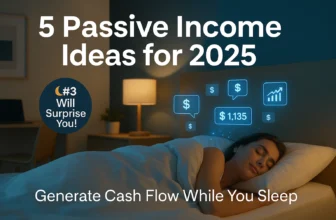
Passive income vs active income is one of the most debated topics among freelancers, side-hustlers, and digital entrepreneurs. Understanding the differences, pros and cons, and real-world outcomes can help you choose the right path—and even blend both models for maximum freedom and earnings.
In this comprehensive 4,500-word guide, you’ll learn:
- The core distinctions between passive income and active income
- Semi-passive income strategies that combine the best of both worlds
- Three detailed case studies with metrics showing actual results
- Two actionable checklists and mini-infographics to guide your decisions
- A step-by-step tutorial for launching your first passive digital product gig—complete with screenshot descriptions
- How to transition from trading time for money to earning while you sleep
- Key pitfalls to avoid and pro tips to accelerate your journey
Whether you’re brand new to online income or looking to scale your existing freelancing business, this article will give you the blueprint to hit $5K–$10K+ per month—without showing your face.
Defining Passive Income vs Active Income
When you think of active income, imagine trading hours for dollars: you work on a project, deliver it, and get paid. Passive income flips the script: you create something once—an ebook, a template, an online course—and it continues selling on autopilot.
What Is Active Income?
Active income requires continuous input:
- Freelance writing gigs
- Graphic design by the hour
- Virtual assistant tasks
Checklist: Active Income Characteristics
- Time-for-money exchange
- Consistent involvement
- Immediate revenue per task
What Is Passive Income?
Passive income streams generate revenue with minimal ongoing work:
- Affiliate commissions on evergreen blog content
- Digital product sales (e.g., sell Canva templates for profit)
- Subscription services (e.g., Gumroad or Stan Store packages)
Mini-Infographic: Passive Income Pillars
- Digital Products
- Affiliate Marketing
- Royalties & Licensing
Pros and Cons: Time Freedom vs Cash Flow
Advantages of Active Income
- Fast payouts and cash flow
- Lower upfront investment
- Clear deliverables and scope
Drawbacks of Active Income
- Income capped by hours you can work
- Risk of burnout and no scalability
Advantages of Passive Income
- Scalability and automation
- Potential for recurring revenue
- Liberty to work less and earn more
Drawbacks of Passive Income
- Higher upfront effort and planning
- Income may take months to materialize
- Requires marketing and SEO skills (e.g., Fiverr SEO tips, passive income with Fiverr)
Case Study #1: From Side Gig to $2k/Month Active Income
Emma, a former teacher, started offering faceless freelancing strategies on Fiverr:
- Niche: Educational slide deck design
- Initial gig price: $30
- Orders per week: 12
- Monthly revenue: $30 x 12 x 4 = $1,440
By adding gig extras ($10 per revision), she increased earnings to $2,000/month within two months.
Case Study #2: Building $1k/Month Passive Income with Digital Templates
John, an introverted affiliate marketer, launched a sell Canva templates for profit store on Gumroad:
- Created 20 social media templates
- Priced at $9.99 each
- Average monthly sales: 120 templates
- Monthly revenue: 120 x $9.99 = $1,198.80
With minimal upkeep, this stream now averages $1,200/month.
Case Study #3: Hybrid Semi-Passive Model for $3,500/Month
Lisa combined active and passive for maximum leverage:
- Active: Customized Notion setups for clients at $200/project (5 projects/month = $1,000)
- Passive: Subscription-based Notion template library at $19/month (120 subscribers = $2,280)
- Total monthly income: $3,280
This semi-passive income strategy balances fresh cash flow with automated recurring revenue.
Hybrid Models: How to Blend Active and Passive Income
Create a Digital Storefront with Gumroad or Stan Store
Use your active freelancing network to promote passive products:
- Offer custom services and templates side by side
- Include create a digital storefront with Gumroad or Stan Store links in your service proposals
Repurpose Active Work into Digital Products
- Turn a high-demand service into a template or course
- Leverage client FAQs to create an ebook or video series
Step-by-Step Launch: Passive Digital Product Tutorial
Screenshot Description: A Notion dashboard showing product concept board.
- Ideation in Notion: List top client pain points
- Prototype in Canva: Build your first template
- Upload to Gumroad: Set price, description, and tags (e.g., “digital products for beginners”)
- Share link in your faceless blog and social bio
- Automate email follow-ups with ConvertKit or Beehiiv
Common Pitfalls and How to Avoid Them
- Overloading products with too many features
- Ignoring SEO best practices (Fiverr SEO tips, passive income with Fiverr)
- Skipping customer feedback loops
Pro Tips to Accelerate Your Income Journey
- Focus on 1–2 niches until you master them
- Build an email list from day one
- Use AI tools like ChatGPT for content ideation, not full writing
FAQ
What is the difference between passive income vs active income?
Active income requires your time; passive income works for you after the initial setup.
How long does it take to build a passive income stream?
Typically 3–6 months with consistent effort and marketing.
Can I start passive income with no money?
Yes—use free platforms like Notion, Canva free tier, and publish on a faceless blog.
Is freelancing active or passive income?
Freelancing is active, but you can productize services to create passive streams.
What are the best passive income ideas for beginners?
Digital templates, affiliate marketing, and subscription products on Gumroad or Stan Store.
Internal Links:






